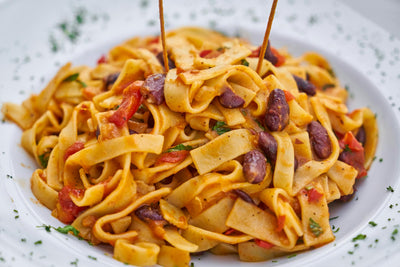Storing Rice in the Fridge
Storing cooked rice properly in the refrigerator is crucial for maintaining its quality and ensuring it is safe to eat. Rice is a staple in many diets worldwide, and proper storage can help you enjoy your favorite dishes while minimizing waste.
Importance of Proper Storage
Preserving perfectly cooked rice is not only about retaining its flavor and texture but also about food safety. Rice can contain spores of a bacterium called Bacillus cereus, which can survive the cooking process. If cooked rice is left at room temperature for too long, these spores can grow into bacteria that may produce toxins causing food poisoning. Therefore, rapid cooling and refrigeration are key to preventing the proliferation of harmful bacteria and preserving the quality of the rice.
Factors Affecting Rice Storage
Several factors influence how long you can safely store rice in the fridge:
- Temperature: Rice should be cooled quickly to room temperature and then refrigerated at temperatures below 40°F (4°C) to slow bacterial growth.
- Moisture: Rice stored in the fridge should be kept in an airtight container to maintain moisture and prevent drying out.
- Type of Rice: Different types of rice, such as white, brown, or wild rice, may have slightly different storage times due to their varying oil content and structure.
- Additives: Any additional ingredients mixed with the rice, such as vegetables, sauces, or proteins, can affect its shelf life.
Properly stored rice can be a versatile ingredient for quick meals or creative culinary endeavors. For those looking to revamp their kitchen storage options, exploring the best narrow side by side refrigerators or choosing the right 24 inch undercounter freezer can help maximize space and efficiency. And for those curious about how long other common foods last in the fridge, check out our articles on maximizing chickens shelf life, the time bread can survive in the fridge, or how long your pizza is good for.
By understanding the importance of proper storage and the factors that affect rice's shelf life, you can ensure that your rice remains delicious and safe to consume. For more detailed guidelines on storing rice and other foods, visit our comprehensive guide on how long is rice good in the fridge.
Shelf Life of Cooked Rice
Cooked rice, a staple in many kitchens, requires proper storage to maintain its quality and safety. Understanding how long you can keep this versatile grain in the fridge, and recognizing when it has gone bad, is essential to prevent foodborne illnesses.
How Long Can You Safely Store Cooked Rice in the Fridge?
You can generally store cooked rice in the refrigerator for up to four to six days. It's important to cool the rice as quickly as possible (within one hour) after cooking and place it in the fridge to minimize the risk of bacterial growth.
Here's a table summarizing the shelf life of cooked rice under different conditions:
| Storage Condition | Shelf Life |
|---|---|
| Room Temperature | 1 Hour Max |
| Refrigerated (40°F or below) | 4-6 Days |
| Frozen (-18°C or 0°F) | 1 Month |
To maximize the freshness of your cooked rice and ensure it remains appetizing, consider the storage solutions provided by modern refrigeration technology. For instance, a 33 inch french door fridge offers ample space and efficient cooling for safe food storage.
Signs of Spoiled Cooked Rice
Spoiled cooked rice is often detectable by a sour smell, a change in texture, and sometimes visible mold. If you notice any of these signs, it's vital to discard the rice immediately:
- Smell: A sour or "off" odor that is distinct from the mild, starchy scent of fresh rice.
- Texture: A slimy or mushy texture not present when the rice was first cooked.
- Visual Indicators: Discoloration, mold, or any other unusual signs on the surface of the rice.
If you're uncertain about the freshness of your rice, err on the side of caution and do not consume it. Always remember that properly storing your rice can help extend its shelf life. Explore our article on extend your rice's life how long is rice good in the fridge for more detailed storage guidelines and tips.
Extending the Shelf Life
Properly storing your cooked rice can significantly extend its shelf life and maintain its quality. By following these preservation tips and choosing the right storage containers, you can enjoy your rice safely for a longer period.
Tips for Preserving Cooked Rice
To preserve your cooked rice perfectly, it's crucial to cool it down promptly after cooking. You should aim to refrigerate rice within two hours of cooking to prevent the growth of harmful bacteria. Here are some tips to ensure your rice remains safe and tasty:
- Cool Quickly: Spread your cooked rice on a baking sheet to allow it to cool faster before refrigerating.
- Refrigerate Promptly: Once cooled, transfer the rice to the fridge without delay.
- Maintain Optimal Temperature: Ensure your refrigerator temperature is set below 40°F (4°C) to keep the rice in a safe zone.
- Limit Oxygen Exposure: Minimize the rice's exposure to air to prevent bacteria growth and preserve freshness.
- Store in Portions: Divide the rice into smaller portions, which will cool more quickly and make reheating easier.
For more information on maintaining the right refrigerator temperature, explore our article on choosing a french door fridge with ice maker integration.
Proper Storage Containers
Selecting the appropriate storage container is key to extending the shelf life of your cooked rice. Containers should be airtight, moisture-proof, and made of food-safe materials. Here are characteristics you should look for:
- Airtight Lids: Containers with tight-fitting lids prevent air and moisture from getting in, which can spoil the rice.
- Clear Containers: These allow you to easily identify the contents and monitor the condition of the rice without opening the container.
- BPA-Free Plastics or Glass: Choose containers made from BPA-free plastics or glass to avoid chemical contamination.
- Microwave-Safe: For convenience, use containers that are safe to use in the microwave when reheating rice.
| Container Type | Characteristics |
|---|---|
| Plastic Containers with Lids | Airtight, may be stackable, lightweight |
| Glass Containers with Lids | Airtight, durable, may be oven-safe |
| Reusable Silicone Bags | Airtight, flexible, space-saving |
By following these preservation tips and choosing the proper storage containers, you can extend the shelf life of your cooked rice, ensuring it remains safe and delicious for your next meal. For additional insights on food preservation, take a look at our guide on extending the shelf life of cooked chicken in the fridge.
Reheating Stored Rice
Proper reheating of stored rice is crucial to enjoying its taste and ensuring it's safe to eat. When you are ready to reheat your chilled rice, follow these guidelines to maintain its quality and your health.
Safe Ways to Reheat Stored Rice
To reheat your rice safely, you have a few options:
- Microwave: Place the rice in a microwave-safe dish, sprinkle some water to add moisture, cover it loosely, and heat it until it's hot throughout. Stir occasionally to ensure even heating.
- Stovetop: Transfer the rice into a pot, add a small amount of water, and cover it with a tight-fitting lid. Heat on a low flame, stirring occasionally, until it’s thoroughly warmed.
- Steaming: For those who prefer not to dry out their rice, steaming is a gentle way to reheat. Place the rice in a steamer basket over boiling water, cover, and steam until hot.
When reheating rice, the internal temperature should reach 165°F or 74°C to ensure it's safe to consume. Using a food thermometer can help in checking the temperature accurately.
Precautions to Take
- Time Frame: Consume reheated rice within 1-2 hours to minimize the risk of bacterial growth.
- Avoid Repeated Reheating: Only reheat the portion of rice you plan to eat. Repeatedly reheating the same batch of rice increases the risk of foodborne illness.
- Check for Spoilage: Before reheating, inspect the rice for any signs of spoilage, including off-odors, discoloration, or mold. If in doubt, it’s best to discard it.
For more information on the shelf life of cooked rice and how to determine if it has spoiled, visit our detailed guide on preserving perfectly how long can you safely store rice in the fridge. Remember that the key to enjoying your rice safely lies in both proper storage and reheating techniques.
Freezing Cooked Rice
Freezing cooked rice is a great way to extend its shelf life and ensure you have a quick and convenient side dish available at all times. But can you freeze cooked rice, and if so, how do you do it properly?
Can You Freeze Cooked Rice?
Yes, you can freeze cooked rice! When preserved correctly, freezing rice can maintain its quality and prevent food waste. Freezing is especially useful if you've cooked rice in bulk or want to save leftovers for later use. It's a practical solution for those who desire to have ready-to-eat rice on hand without compromising taste or texture.
Best Practices for Freezing Rice
To guarantee the best results when freezing cooked rice, follow these best practices:
-
Cool It Down: Before you freeze the rice, allow it to cool completely. Spreading the rice out on a baking sheet can expedite the cooling process.
-
Portion Control: Divide the rice into portions that you would typically consume. This prevents thawing more rice than needed and avoids potential waste.
-
Airtight Containers or Freezer Bags: Store the rice in airtight containers or resealable freezer bags. This helps to prevent freezer burn and preserve the rice's moisture content.
Container Type Pros Cons Airtight Containers Reusable, sturdy Bulky, takes up more space Freezer Bags Space-saving, flexible Single-use, less environmentally friendly -
Labeling: Label each container or bag with the date of freezing. Cooked rice can be stored in the freezer for up to one month for the best quality.
Portion Size Rice Type 2 cups Basmati 1 cup Brown -
Prevent Freezer Burn: Expel as much air as possible from freezer bags before sealing. When using containers, fill them to the top or place a layer of plastic wrap directly on the surface of the rice before sealing the lid.
By adhering to these best practices, your cooked rice will retain its texture and flavor when thawed and reheated. Whether you’re storing rice in a spacious French door refrigerator or a compact undercounter freezer, proper freezing methods are key. For those with specific storage needs, consider exploring options like a narrow side by side refrigerator or a luxurious 48-inch side by side model. Additionally, to learn more about how to prolong the shelf life of other foods in your fridge, you might be interested in articles such as maximizing chicken's shelf life or unlocking the time bread can survive in the fridge.
Using Frozen Rice
After you have taken the step to freeze your cooked rice, knowing the correct methods for thawing and reheating it is key to maintaining its quality and safety. Here are the best practices for using your frozen rice.
Thawing Frozen Rice
To thaw your frozen rice, you have several options depending on the amount of time you have available:
- Refrigerator Thawing: Transfer the rice from the freezer to the refrigerator and let it thaw overnight. This method is the safest as it keeps the rice at a consistent, cool temperature, reducing the risk of bacterial growth.
- Cold Water Thawing: Place the rice in a leak-proof bag and submerge it in cold water. Change the water every 30 minutes until the rice is thawed. Make sure to cook immediately after thawing.
- Microwave Thawing: Use the microwave's defrost setting to thaw the rice if you're in a rush. Since this method can partially cook the rice, it's important to reheat and consume it immediately after thawing.
Always ensure the rice reaches a safe internal temperature of 165°F (74°C) when reheated, regardless of the thawing method used. For insights into the best fridges and freezers for food preservation, explore our guide on maximize space with style best narrow side by side refrigerators.
Reheating Frozen Rice Safely
Once thawed, reheating your rice properly is essential for both taste and food safety:
- Stovetop: Add a little bit of water to the rice in a saucepan to prevent drying out. Heat it on medium heat, stirring occasionally, until it is hot all the way through.
- Microwave: Place rice in a microwave-safe dish and sprinkle some water over it to retain moisture. Cover the dish with a lid or microwave-safe plastic wrap to trap steam and reheat it until it's hot throughout.
| Method | Time (Approx.) | Additional Tips |
|---|---|---|
| Stovetop | 3-5 minutes | Stir to avoid sticking |
| Microwave | 1-3 minutes | Fluff with a fork post-heating |
For those concerned about energy efficiency and appliance performance, you can find more information in our article discussing the amp usage of refrigerators.
By properly thawing and reheating your frozen rice, you can enjoy its convenience without compromising on taste or safety. Remember, if you're unsure about the rice's condition after thawing, it's best to err on the side of caution and discard it to prevent foodborne illness. For further details on food preservation, check out our article on extend your rices life how long is rice good in the fridge.
Repurposing Leftover Rice
Leftover rice need not go to waste; it can be the foundation of many delicious and creative dishes. Here's how you can transform your refrigerated rice into a variety of tasty meals.
Creative Ways to Use Leftover Rice
- Fried Rice: An excellent way to use leftover rice is by stir-frying it with vegetables, proteins of your choice, and a mix of soy sauce and sesame oil.
- Rice Pancakes: Combine rice with egg, cheese, and breadcrumbs to form patties, and pan-fry them until golden and crispy.
- Stuffed Peppers: Mix rice with a protein, spices, and sauce, then stuff it into bell peppers and bake.
- Rice Pudding: Sweeten your rice with milk, sugar, and cinnamon to create a comforting dessert.
- Rice Salad: Toss cold rice with a vinaigrette, fresh vegetables, and herbs for a quick and refreshing salad.
- Rice Soup: Enhance your broth-based soups by adding rice for extra heartiness.
- Rice Fritters: Mix rice with herbs and spices, form into small balls, and deep-fry until crispy.
- Rice Casserole: Layer rice with your favorite sauce, vegetables, and cheese, and bake until bubbly.
- Rice Burritos: Use rice as a filling for burritos, along with beans, cheese, and salsa.
Recipes for Leftover Rice
| Recipe | Ingredients | Instructions |
|---|---|---|
| Classic Fried Rice | Leftover rice, mixed vegetables, soy sauce, eggs | Stir-fry vegetables, add rice and sauce, scramble eggs in the pan. |
| Cheesy Rice Balls | Leftover rice, mozzarella, breadcrumbs, egg | Mix ingredients, form balls, and deep-fry or bake. |
| Rice and Bean Stuffed Peppers | Leftover rice, black beans, tomato sauce, bell peppers | Combine rice and beans, stuff into peppers, bake with sauce. |
| Creamy Rice Pudding | Leftover rice, milk, sugar, cinnamon | Simmer rice with milk and sugar, add cinnamon, chill before serving. |
| Mediterranean Rice Salad | Leftover rice, cucumber, tomato, feta, olive oil | Toss rice with chopped vegetables, feta, and dressing. |
Using leftover rice can be a fun and inventive process, allowing for a range of dishes that cater to all tastes and preferences. Whether you're looking to make a quick meal or get creative in the kitchen, these ideas will ensure that your leftover rice doesn't go to waste. For more ways to optimize your food storage and preserve your meals' freshness, consider exploring the ultimate kitchen essential choosing the ideal 30 refrigerator bottom freezer for ideas on efficient food preservation.
For additional insights on how to maximize your fridge space while keeping different types of food fresh for longer, check out our articles on maximize space with style best narrow side by side refrigerators and revolutionize your storage choosing the right 24 inch undercounter freezer. Remember, when it comes to preserving perfectly how long you can safely store rice in the fridge, food safety is paramount, so always check for signs of spoilage before repurposing your rice.
Final Tips
General Guidelines for Storing Rice
Storing rice properly is key to preserving its freshness and preventing foodborne illness. Here are some general guidelines to ensure your rice remains safe and delicious:
- Cooling: Allow cooked rice to cool to room temperature within two hours of cooking to prevent bacterial growth.
- Transferring: Place cooked rice in a shallow container for rapid, even cooling.
- Sealing: Use an airtight container to protect rice from contaminants and moisture.
- Labeling: Always label your containers with the date of storage to keep track of freshness.
- Limiting Storage Time: Aim to consume refrigerated rice within the recommended time frame of 3 to 5 days.
For those with specific storage needs, consider exploring options such as narrow side by side refrigerators or undercounter freezers to maximize space and functionality.
Additional Food Safety Tips
To maintain the highest standards of food safety, follow these additional tips:
- Refrigerator Temperature: Ensure your refrigerator is at or below 40°F (4°C) to inhibit bacterial growth.
- Cross-Contamination: Prevent cross-contamination by storing rice away from raw foods, particularly meats.
- Reheating: When reheating rice, make sure it reaches an internal temperature of 165°F (74°C).
- Leftovers: If you're unsure about the safety of your rice, err on the side of caution and discard it.
For further information on storing other food items effectively, check out our articles on extending the shelf life of chicken and understanding how long pizza and cooked pasta can last in your fridge.
By following these guidelines, you can enjoy your rice to the fullest while ensuring it's safe for consumption. Remember, when it comes to food storage, it's better to be safe than sorry.
Get Your Upgrade or New Addition at Fridge.com
Shop the world's best brands at Fridge.com.
Whether you're searching for your perfect fridge, freezer, wine fridge, beer fridge, ice maker, or kegerator, we have what you need.
We also have tons of awesome articles about kitchen stuff and home news. Enhance your home, garage, backyard, patio, and office with the coolest essentials. With every necessary type of residential refrigerator or freezer in our collection, we've got you covered.
Elevate your game and shop now at Fridge.com!






